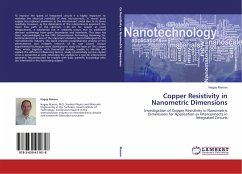To improve the speed of integrated circuits it is highly important to minimize the electrical resistivity of their interconnects. In recent years copper has replaced aluminum as the interconnect metal due to its lower resistivity. However, as the dimensions of the interconnects approach the mean free path of the electrons (~40 nm for copper at room temperature), a substantial rise in resistivity occurs due to additional electron scatterings from grain boundaries and interfaces. This issue has been acknowledged by the ITRS (International Technology Roadmap for Semiconductors) as one of the important obstacles (and challenges) for the microelectronic industry. This book presents comprehensive analysis of this phenomenon and in-depth research of its root causes. Unique experimental techniques were developed to study this issue on thin copper films, which together with theoretical models, enable to identify and explain the different influencing factors. Study of extremely narrow copper wires is presented as well, extending the analysis to a real 3D interconnect geometry. Recommended for readers with basic scientific knowledge who are interested in this fascinating subject.
Bitte wählen Sie Ihr Anliegen aus.
Rechnungen
Retourenschein anfordern
Bestellstatus
Storno








